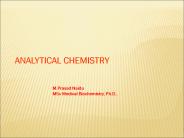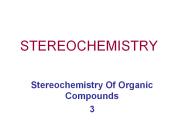Adsorption Chromatography Reagents PowerPoint PPT Presentations
All Time
Recommended
Adsorption Chromatography Reagents Market
| PowerPoint PPT presentation | free to download
The global adsorption chromatography reagents market was valued at $958.0 million in 2013, to grow at a CAGR of about 10.2% from 2013 to 2018. It is expected to reach $1559.0 million by 2018.
| PowerPoint PPT presentation | free to download
The Asian adsorption chromatography reagents market is segmented on the basis of technologies, applications, end-users, and others. The market segmented in terms of applications includes analytical chromatography reagents and preparative chromatography reagents
| PowerPoint PPT presentation | free to download
The global adsorption chromatography reagents market was valued at $958.0 million in 2013, to grow at a CAGR of about 10.2% from 2013 to 2018. It is expected to reach $1559.0 million by 2018. The increasing use of chromatography reagents in the pharmaceutical industry, enhanced investments in chromatography research by governments and companies, and technological advancements in chromatography systems are expected to drive the adsorption chromatography reagents market. However, the presence of alternate separation technology may restrain the growth of adsorption chromatography reagents market.
| PowerPoint PPT presentation | free to download
Complete report available @ http://goo.gl/sRLCgl . Chromatography Reagents can be segmented by geographies, end-users, macroindicators, companies, processes, types, products, applications, and technologies. Geographies of this market are North America, Europe, Asia, and Rest of the World. End-users of this market are Academics, Pharmaceuticals, Food & Beverage (Industry), Hospitals, Environmental Biotechnology, Cosmetics, Nutraceuticals, and others. Macroindicators of this market are Healthcare Expenditure.
| PowerPoint PPT presentation | free to download
Chromatography Reagents Market categories by Type [Acylation, Alkylation, Solvent, Buffer], Bed Shape [Column, Thin layer], Mobile Phase [UHPLC, HPLC, HILIC, Flash, SFC], Separation Mechanism [Partition, Adsorption, Affinity] & End User.
| PowerPoint PPT presentation | free to download
Global Chromatography Reagents Market add up to the total Chromatography market.Chromatography Reagents can be segmented by geographies, end-users, macroindicators, companies, processes, types, products, applications, and technologies.
| PowerPoint PPT presentation | free to download
This report studies the global chromatography reagents market over the forecast period of 2013-2018.The market isestimated at $4,598.0 million in 2013 and is poised to grow at a CAGR of 10.6% from 2013 to 2018, to reach $7,609.3 million by 2018.
| PowerPoint PPT presentation | free to download
Affinity chromatography, commonly termed as protein purification technique is basically a process of bioselective adsorption. It mainly caters to precise and accurate examination of clinical samples that utilizes liquid chromatography methods.
| PowerPoint PPT presentation | free to download
Chromatography Reagents Market categories by Type [Acylation, Alkylation, Solvent, Buffer], Bed Shape [Column, Thin layer], Mobile Phase [UHPLC, HPLC, HILIC, Flash, SFC], Separation Mechanism [Partition, Adsorption, Affinity] & End User.
| PowerPoint PPT presentation | free to download
The Asian analytical chromatography reagents market is considered to be one of the emerging markets in the healthcare industry. The market is estimated to witness a CAGR of 13.3% from 2013 to 2018. The growth in the market is due to the increasing government funding for the chromatography-based researches. Increased investments by the leading companies in the Asian region are also driving the market.
| PowerPoint PPT presentation | free to download
The European Partition Chromatography Reagents Market is considered as the second largest market in this segment. Partition Chromatography Reagents-Europe constitutes of 29.4% of the global partition chromatography reagents market, and is poised to grow at a CAGR rate of 6.89% from 2012 to 2018.
| PowerPoint PPT presentation | free to download
Introduction to Protein Purification Principles of Chromatography Affinity Chromatography Richard Bu
| PowerPoint PPT presentation | free to view
The North American Affinity Chromatography Reagents Market has witnessed dynamic advancements in designing columns and developing better performing resins and reagents. Expanding pharmaceutical and biotechnological industries has laid a huge impact on propelling its market growth.
| PowerPoint PPT presentation | free to download
Chromatography Intro basic terminology types Partition and Adsorption C Ion-Exchange C Gel Filtration (aka Exclusion or Molecular Sieve) C
| PowerPoint PPT presentation | free to download
gas chromatography
| PowerPoint PPT presentation | free to view
1903 Tswett - plant pigments separated on chalk columns (radial chromatography) ... each component of the mixture, and many cycles of this process during elution ...
| PowerPoint PPT presentation | free to view
Chapter 4 High Performance Liquid Chromatography HPLC 1952 A.J.Martin and R.L.M.Synge received the Nobel Prize for the discovery of ...
| PowerPoint PPT presentation | free to download
It is based on the different affinity of individual ... Figure 4. HPTLC Chromatogram of Radix Ginseng from different places. The new technology of TLC: ...
| PowerPoint PPT presentation | free to view
PLANNAR CHROMATOGRAPHY It includes two types: 1- Thin Layer Chromatography (TLC). 2- Paper Chromatography (PC). Thin Layer Chromatography (TLC) In this type a thin ...
| PowerPoint PPT presentation | free to view
The following are the important components of a typical TLC system: ... F plate is used, the sample spots will appear as black spots on a fluorescent green background ...
| PowerPoint PPT presentation | free to view
2) Vanillin and vanillyl alcohol in acetone, 50-50 toluene/ ethyl acetate and hexane ... aromatic hydrocarbons using acetone. The components ...
| PowerPoint PPT presentation | free to view
Different analytes have different equilibria between the mobile phase and stationary phase ... Isocratic, Fig 25-25 Harris. Find the best methanol separation ...
| PowerPoint PPT presentation | free to download
The North American ion pairing reagents report defines and segments the concerned market in North America with analysis and forecast of revenue.
| PowerPoint PPT presentation | free to download
Mitsubishi AQF-100: Solid/Liquid Autosampler, Automatic Boat Controller, Furnace ... The Mitsubishi/Dionex AQF/GA-100 Combustion IC System provides an integrated ...
| PowerPoint PPT presentation | free to view
HL Chemistry - Option A : Modern Analytical Chemistry. Chromatography ... Solubility the degree to which a material (solute) dissolves into a solvent. ...
| PowerPoint PPT presentation | free to view
Chromatographs column eluent tank injector pump detector PC CHROMATOGRAM Qualitative & Quantitative information Flash injector 200:1 Splitless injector Flash injector ...
| PowerPoint PPT presentation | free to download
Chromatography involves a sample (or sample extract) being dissolved in a mobile ... to separate molecules based on differences in charge, size and hydrophobicity. ...
| PowerPoint PPT presentation | free to view
Normal Phase (very polar) Adsorption (very non-polar) Ion-Exchange (ionic) ... Elution volume vs. molecular weight. Pore size of the gel defines the MW range ...
| PowerPoint PPT presentation | free to download
Methods in Enzymology - several volumes are concerned exclusively with ... can be used for separation (size, charge, hydrophobicity, ligand specificity) ...
| PowerPoint PPT presentation | free to view
Acetic acid 6.0 1.370 118 1.1. Acetonitrile 5.8 0.65 1.341 82 0.34 190 ... Mobile phase : 2mM phthalic acid 1.84mM tris 300mM boric acid(pH4.0) ...
| PowerPoint PPT presentation | free to view
What Is HPLC? Basic Principles *
| PowerPoint PPT presentation | free to download
Invented by a Russian botanist named Mikhail Tswett in 1903. ... Fast Protein Liquid Chromatograph (FPLC) 1. 2. 3. 5. 4. No air bubbles (Priming) ...
| PowerPoint PPT presentation | free to view
Forensic Science ( ) IJSO Training (Phase 3) Dr. Kendrew K. W. Mak Department of Chemistry The Chinese University of Hong Kong * * Reference for s 3 ...
| PowerPoint PPT presentation | free to download
Separation Techniques
| PowerPoint PPT presentation | free to view
description and principles of GC and HPLC
| PowerPoint PPT presentation | free to download
Chem 551 :Instrumental Methods of Analysis Ralph Allen
| PowerPoint PPT presentation | free to download
Galvanic and Electrolytic Cells. Galvanic cells produce electrical energy. ... Galvanic Cells. Electrolytic Cells. Schematic Representation of Electrochemical Cells ...
| PowerPoint PPT presentation | free to view
... move up at different rates, depending on intermolecular forces between ... The separation between two analytes on a chromatogram can be expressed as the ...
| PowerPoint PPT presentation | free to view
Capillary Electrophoresis as a Means of Quality Control for Cough Syrup Containing Ephedrine Tumbur Hutabarat Faculty of Biopharmaceutical Sciences (Pharmacognosy ...
| PowerPoint PPT presentation | free to download
Title: Chem. 31 9/15 Lecture Author: RDixon Created Date: 9/14/2005 7:27:31 PM Document presentation format: On-screen Show (4:3) Company: CSUS
| PowerPoint PPT presentation | free to download
Standard ISO smoking for Tar (NFDPM), Nicotine and Carbon Monoxide. ... specific compounds as it tends to adsorb all vapour compounds available in smoke ...
| PowerPoint PPT presentation | free to download
Elution - The process of passing a liquid or gas through a column. Eluent ... Detector response as a function of time or elution volume ...
| PowerPoint PPT presentation | free to view
Shot noise - pulses. 1/f (flicker) noise - important at low ... Double pan balance - mesure multiple objects simultaneously & measure linear combinations ...
| PowerPoint PPT presentation | free to view
Industry TSE clearance studies for plasma-derived Factor VIII (pdFVIII) Dr. Thomas R. Kreil, Chair, PPTA Pathogen Safety Steering Committee FDA TSE Advisory Committee
| PowerPoint PPT presentation | free to view
STEREOCHEMISTRY Stereochemistry Of Organic Compounds 3
| PowerPoint PPT presentation | free to view
STEREOCHEMISTRY Stereochemistry Of Organic Compounds 3 3.1 CONCEPT OF ISOMERISM Berzelius coined the term isomerism (Greek: isos = equal; meros = part) to describe ...
| PowerPoint PPT presentation | free to view
Quality control for efficacy and safety of herbal products is of paramount importance. ... No regulatory definition exists for standardization of dietary supplements. ...
| PowerPoint PPT presentation | free to view
SNAKE BITE PROBLEM AND RELATED RESEARCH QUESTIONS WITH SPECIAL REFERENCE TO SE ASIA
| PowerPoint PPT presentation | free to view
Chem 551 :Instrumental Methods of Analysis
| PowerPoint PPT presentation | free to view
Organic Chemistry Courtney Eichengreen courtney.eichengreen@ucdenver.edu 719.321.4187 * * Know bolded * Don t memorize, but understand may come up in MCAT ...
| PowerPoint PPT presentation | free to view
Absorbance values are determined on a spectrophotometer at 750 nm. ... then easily determined with a spectrophotometer using a standard curve with ...
| PowerPoint PPT presentation | free to view
Easy-to-use, cost/effective, reliable, and affordable technology ... Bovine Viral Diarrhea Virus (BVDV) as a recognized model for HCV ...
| PowerPoint PPT presentation | free to view
introduction about hplc and gpc
| PowerPoint PPT presentation | free to view
























































